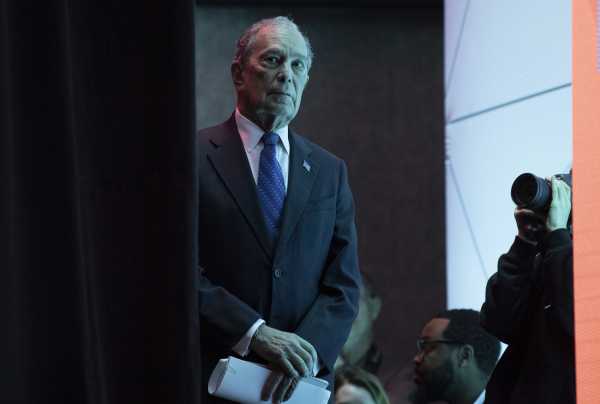
As former New York City Mayor Mike Bloomberg rises in the polls — he’s now fourth in national polling averages — he is also facing renewed criticism over his record with minority communities, even fielding tweets about it from President Donald Trump on Tuesday.
Bloomberg has faced questions over his mayoral policies that affected New York’s nonwhite population before, but after progressive podcaster Benjamin Dixon recirculated Bloomberg’s 2015 speech at the Aspen Institute defending his city’s controversial stop-and-frisk policy on Tuesday, those questions are once again in the national conversation.
“Ninety-five percent of your murders — murderers and murder victims — fit one M.O. You can just take the description, Xerox it and pass it out to all the cops. They are male, minorities, 16 to 25. That’s true in New York, that’s true in virtually every city,” Bloomberg said in the video clip.
“We put all the cops in minority neighborhoods,” Bloomberg said. “Yes. That’s true. Why do we do it? Because that’s where all the crime is. And the way you get the guns out of the kids’ hands is to throw them up against the walls and frisk them.”
A number of other Twitter users began to attack Bloomberg with the hashtag #BloombergIsRacist, which Dixon included in his initial tweet and which trended for much of Tuesday.
The furor led others on Twitter to bring to the fore more criticisms of Bloomberg, like that he has supported Republicans in the past. It also led to the resurfacing of other comments he has made around policing and people of color, like one from a 2013 episode of Bloomberg’s then-weekly radio program on WOR-AM, in which he cited statistics on the ethnicities of murders and murder victims and said, “I think we disproportionately stop whites too much, and minorities too little.”
Trump, who has a long record of racist remarks — including a 2017 speech in which he said he didn’t want police to be “too nice” to “thugs” — piled on as well. “Wow, Bloomberg is a total racist!” he tweeted.
He deleted that tweet but kept a reply to another tweet that attempted to link him to Bloomberg that was critical of the former mayor’s golf game, calling Bloomberg “a short ball (very) hitter.”
Stop-and-frisk and Bloomberg’s record
Bloomberg did not institute the stop-and-frisk program in New York City but inherited it from his predecessor, Rudy Giuliani. The initiative was implemented on the grounds that it would reduce crime through random searches of New York City residents. This theory turned out to be suspect, but the policy’s effects were clear in another way. New York Police Department data clearly showed that most of the people being stopped and frisked were black or Latinx even though police found weapons and contraband on white residents more, as Vox’s German Lopez explained.
As Matthew Cella and Alan Neuhauser noted for US News and World Report in 2016, FBI data shows populations of color were more affected by homicide than white populations in 2015:
But it is important, as Emily Widra noted for the Prison Policy Initiative, to keep in mind that the black population is lower than the white population, so that rate means a black American is more likely to be murdered than a white one. The Centers for Disease Control and Prevention found that the homicide rate for black Americans in 2015 was 20.9 per 100,000 people, while the rate for white Americans was 2.6 per 100,000 people.
This would seem to prove the points Bloomberg made in 2015, but looking only at these numbers ignores a broader cultural context. The problem with the former mayor’s statements is that broadly painting young nonwhite men as the most likely perpetrators of violence not only perpetuates ugly and racist stereotypes and needlessly vilifies millions of people — it also does nothing to bring down murder rates.
After a court ruled stop-and-frisk unconstitutional in 2013, the effectiveness of the program was further called into question due to the fact that even without it, crime continued to decrease, reaching historic lows. Nevertheless, Bloomberg defended it both as mayor and, as Dixon showed, after he left office in 2013. Recently, however, he has begun to apologize for this past stance.
Bloomberg’s support for stop-and-frisk has been a problem for him before. In December, in an interview Bloomberg did with CBS’s Gayle King, he falsely claimed, “Nobody asked me about it until I started running for president, so, c’mon.”
Many observers were quick to refute that claim, including former CNN anchor Soledad O’Brien, who tweeted that the former mayor defended the policy at a 2014 cocktail party by arguing “that MORE black and brown people should have been stopped.”
Nevertheless, Bloomberg is running for the Democratic nomination, and he seems to recognize support for the policy could be a problem for him.
“I can’t change history,” Bloomberg said last November. “However today, I want you to know that I realize back then I was wrong.”
Bloomberg is campaigning against Trump
Bloomberg worked to place the focus back on Trump on Tuesday, saying in a statement, “President Trump’s deleted tweet is the latest example of his endless efforts to divide Americans.”
He also argued that stop-and-frisk wasn’t his idea but was begun by Mayor Rudy Giuliani’s administration, that he did his best to curb it, and that while he may have once defended the practice, he has come to see the error of his ways: “I have apologized — and I have taken responsibility for taking too long to understand the impact it had on Black and Latino communities … this issue and my comments about it do not reflect my commitment to criminal justice reform and racial equity.”
Bloomberg may indeed be sorry, but the fact that he didn’t offer that apology until he decided he wanted to run for president incenses his critics. And it still is not exactly clear where he stands on the issue of stop-and-frisk. As Zeeshan Aleem has noted for Vox, Bloomberg has “unapologetically defended the program as recently as January as an effective deterrent against crime,” a defense that came two months after his November apology.
Such defenses discount the fact that the NYPD’s stop-and-frisk tactics were found to be unconstitutional in 2013, and that falling crime rates after the program’s cancellation suggest it had no effect on crime.
And, of course, Bloomberg’s 2015 claims aren’t exactly true, particularly his claim that all of New York’s crime was in majority-minority neighborhoods.
It is true the boroughs with greater populations of color — the Bronx and Brooklyn — had the most murders in 2015. However, these are also two of the most populous boroughs (with Brooklyn being the most populous in 2015), and Manhattan led the city in other crimes that year, like larceny. And it wasn’t like the city was some lawless murder capital that year — the New York Police Department recorded 352 murder and cases of non-negligent manslaughter that year in a city that, at the time, contained 8.5 million people.
As Bloomberg’s national profile grows — he’s already spent more than $300 million on advertising — and as he works to try to win big on Super Tuesday, his record is likely to face continued scrutiny.
That analysis will likely raise new questions about the former mayor’s views on race and religion, from an old joke about conducting New York-Native American relations by shotgun to his past defenses of sweeping surveillance of New York’s Muslim population. It could also lead to further investigation into allegations that Bloomberg has mistreated a number of women — as well as what a number of non
Certainly, these sorts of issues are not necessarily barriers to the Oval Office — Trump, having faced similar allegations of racism and sexism, is president. But it remains to be seen whether Democratic voters — a number of whom have been critical of Trump on these issues — will put forward a nominee with Bloomberg’s record.
Sourse: vox.com






